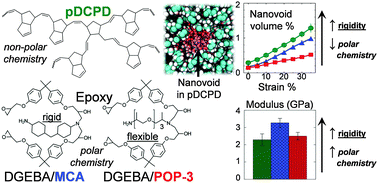Nanovoid formation and mechanics: a comparison of poly(dicyclopentadiene) and epoxy networks from molecular dynamics simulations
Abstract
Protective equipment in civilian and military applications requires the use of polymer materials that are both stiff and tough over a wide range of strain rates. However, typical structural materials, like tightly cross-linked epoxies, are very brittle. Recent experiments demonstrated that cross-linked poly(dicyclopentadiene) (pDCPD) networks can circumvent this trade-off by providing structural properties such as a high glass transition temperature and glassy modulus, while simultaneously exhibiting excellent toughness and high-rate impact resistance. The greater performance of pDCPD was attributed to more facile plastic deformation and nano-scale void formation, but the chemical and structural mechanisms underlying this response were not clear. Here, we use atomistic molecular dynamics to compare the molecular- and chain-level properties of pDCPD and epoxy networks undergoing high strain rate deformation. We quantify the tensile modulus and yield strength of the networks as well as the prevalence and characteristics of nanovoids that form during deformation. Networks of similar molecular weight between cross-links are compared. Two key molecular-level properties are identified – monomer flexibility and polar chemistry – that influence the behavior of the networks. Increasing monomer flexibility reduces the modulus and yield strength, while strong non-covalent interactions (e.g., hydrogen bonds) that accompany polar moieties provide higher modulus and yield strength. The lack of strong non-covalent interactions in pDCPD was found to account for its lower modulus and yield strength compared to the epoxies. We examine the molecular-level properties of nanovoids, such as shape, alignment, and local stress distribution, as well as the local chemical environment, finding that nanovoid formation and growth are increased by the monomer rigidity but decreased by polar chemistry. As a result, the pDCPD network, which has a stiff chain backbone with nonpolar alkane chemistry, exhibits more and larger nanovoids that grow more readily during deformation, which could account for the higher toughness and more ductile behavior observed in pDCPD.


 Please wait while we load your content...
Please wait while we load your content...